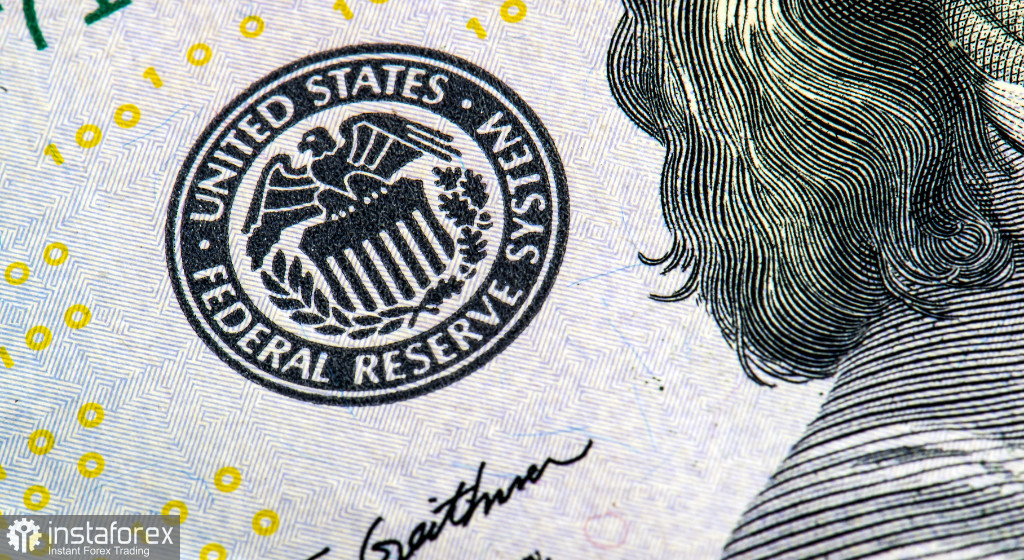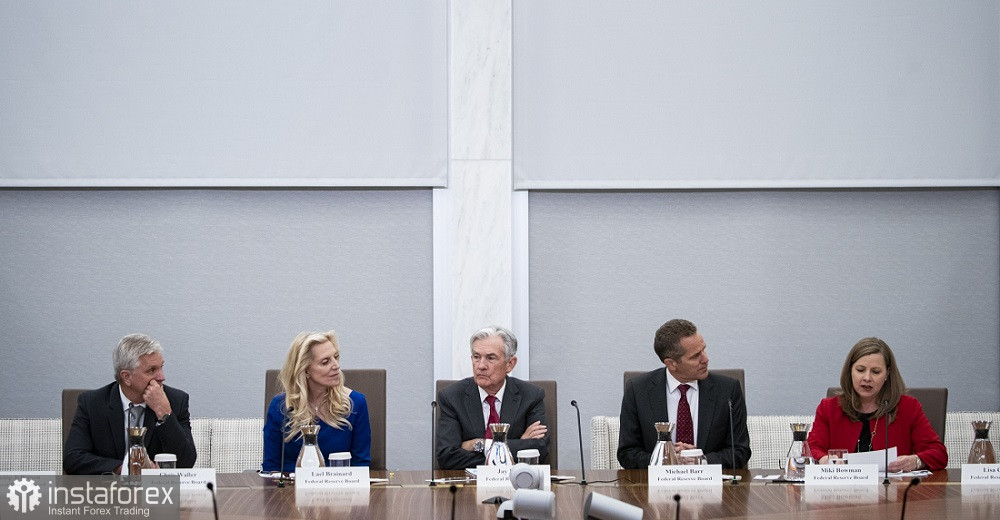The euro-dollar pair tested the area of the 5th figure today, winning back yesterday's release: the minutes of the February Fed meeting supported the U.S. dollar. At the same time, sellers of EUR/USD have not been able to organize a downward rally, and in order to develop a downward trend, they need to overcome the support level of 1.0550, which corresponds to the lower line of the Bollinger Bands indicator on the D1 timeframe. The downward momentum faded last night, but at the same time buyers were unable to seize the initiative to organize a counterattack. As a result, the price drifts at the border of 5 and 6 figures, in a narrow price range. Apparently, both bears and bulls of the pair froze in anticipation of the key macroeconomic report of the current week, which will be released on Friday.
What the Fed minutes told us
The minutes of the February meeting of the Federal Reserve did not provoke price turbulence among dollar pairs, but still provided modest support to the greenback. The published document did not contain any sensational "revelations": all the theses were repeatedly voiced by members of the American regulator – both before and after the February meeting. Therefore, we can only say that the protocol has supplemented the overall fundamental picture, strengthening the dollar's position.

The document itself turned out to be quite "dry," without any important or significant wording. But if we look at it through the prism of inflation reports (published after the February meeting), we can assume that the tone of the Fed's rhetoric will significantly tighten at the March meeting.
Thus, the final communique states that, "most officials" believe a "more significant increase in rates" is needed to reduce inflation. Two points are noteworthy here: first, the majority of the Committee members were concerned about the slow pace of decline in inflation in the United States back in early February. In this case, the wording is really important because depending on the degree of support for a particular message, the regulator uses different definitions ("some" members of the central bank, "some," "many," etc.). Secondly, the above phrase was uttered even before the publication of the latest data on the growth of inflation in the United States. As you know, the rate of decline in the consumer price index and the producer price index slowed down again in January, reflecting an already alarming trend.
Perhaps, this is the only more or less significant element of yesterday's release. All other theses of the document are secondary in the context of the EUR/USD pair. For example, Fed members have expressed concern that U.S. officials have not resolved the issue of the national debt ceiling. In their opinion, the prolonged period of negotiations on this issue "may create significant risks for the financial system and the U.S. economy as a whole."
The minutes also state that Fed members "discussed the risks to financial stability that arose in part from aggressive rate hikes." On the one hand, this wording is dovish in nature, but on the other hand, the Fed, firstly, did not focus on the side effects of tightening the monetary policy and, secondly, it was much more worried about the slow pace of inflation decline, indicating the need for a further increase in the rate.
Market reaction
In general, the dollar strengthened its position in all pairs of the major group. Paired with the euro, the price appeared in the area of the 5th figure for the first time since January. Sellers of EUR/USD are conducting, so to speak, "reconnaissance in force," with an eye on the lower line of the Bollinger Bands indicator on the daily chart (1.0550). In this case, we cannot speak of a dollar rally: the downward dynamics is more of an inertial nature and is accompanied by upward corrective pullbacks. But by and large, the downward trend nevertheless developed. Looking at the EUR/USD weekly chart, we can see that the price has been declining for the fourth week in a row, after peaking at 1.1034 at the end of January.
Conclusions
The minutes of the February meeting of the Fed did not become a sensation. The document only stated the intention of the central bank to maintain a hawkish course to reduce inflation. On the one hand, the theses in the minutes were voiced by members of the regulator more than once after the February meeting. On the other hand, the Fed's "minutes" were published at just the right time (for the dollar bulls): on the rumors that the regulator may return to a 50-point rate hike.

For instance, according to the CME FedWatch Tool, the probability of a 50-point rate hike in March is already 25% (the probability of a 25-point hike is 75%, respectively). A few weeks ago, the 50-point option was not considered likely by the market. This week, two Fed officials—Bullard and Mester—said it would be "appropriate" to raise the rate by 50 points at the end of the February meeting. The "hawkish" Fed minutes, in this case, only added to the overall fundamental picture.
But for the development of the downward trend of EUR/USD, sellers of the pair need another puzzle. We are talking about the core PCE index, which will be released on Friday. If this inflation indicator also turns out to be in the "green zone" (along with the CPI and PPI), the dollar will get another reason to strengthen. In this case, the EUR/USD bears will once again target the 1.0550 support level – overcoming it will allow traders to settle in a new price range, the lower limit of which will lie at 1.0470 (the middle Bollinger Bands line on the weekly chart).
 English
English 
 Русский
Русский Bahasa Indonesia
Bahasa Indonesia Bahasa Malay
Bahasa Malay ไทย
ไทย Español
Español Deutsch
Deutsch Български
Български Français
Français Tiếng Việt
Tiếng Việt 中文
中文 বাংলা
বাংলা हिन्दी
हिन्दी Čeština
Čeština Українська
Українська Română
Română

